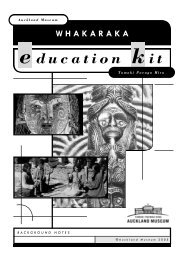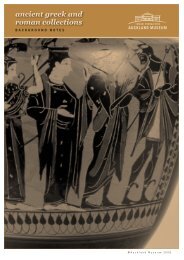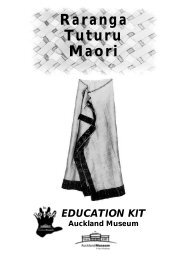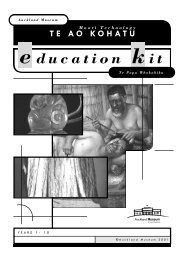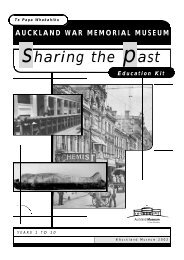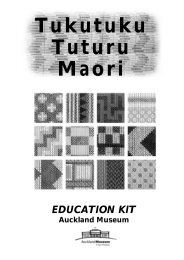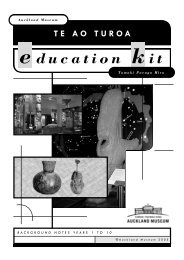Wanted: Oscar Obsidian - Auckland Museum
Wanted: Oscar Obsidian - Auckland Museum
Wanted: Oscar Obsidian - Auckland Museum
Create successful ePaper yourself
Turn your PDF publications into a flip-book with our unique Google optimized e-Paper software.
least 10 pages).<br />
· Use volcano visit information and any other<br />
ideas to construct a diagram of what has happened<br />
to an <strong>Auckland</strong> volcano. Start with the<br />
eruption. Discuss what happens next and continue<br />
to include how Maori and Pakeha may have<br />
changed the volcano.<br />
· Collect newspaper and magazine pictures of<br />
volcanoes around the world. Try and find one<br />
that has been active recently.<br />
2. Rocks<br />
· Use rocks collected and additional volcanic rocks<br />
to group and classify. Divisions may include:<br />
heavy/light, rough/smooth, dark/light etc extend<br />
by including whether they came from a volcano.<br />
Rocks that come from a volcano have holes in<br />
them e.g. scoria and pumice, or else have large<br />
crystals e.g. granite. Play a 'guess my rock group'<br />
game.<br />
· Try some heating and cooling activities. List children's<br />
ideas of what happens to things when they<br />
get heated. Watch a candle melt, boil some<br />
water, look at an element in a heater. Record<br />
before and after ideas pictorially. Make jelly or<br />
toffee. Predict what will happen when the mixture<br />
cools. Children suggest and try different<br />
ways of cooling e.g. on a bench, in a fridge, in<br />
water. Record results. Try changing different<br />
aspects e.g. the size of the container. Does it<br />
affect the cooling? Link the ideas to lava cooling<br />
and rock forming.<br />
· Children could choose a rock that they really<br />
like. Try and give them the correct name for it.<br />
Children could then decide a way that they could<br />
use the rock e.g. for jewellery, building etc, based<br />
on some of its observable properties.<br />
3. Dinosaurs and Fossils<br />
· Borrow fossil samples or use photographs to<br />
group and classify as animal or plant. Include<br />
recent leaves and shells. Animal fossils could be<br />
grouped further into those with wings, sharp teeth<br />
etc.<br />
· Make fossils. Select a shell or bone. Cover in<br />
vaseline and press into plasticine or clay. Remove<br />
the shell and fill the imprint with wet Plaster of<br />
Paris mix. When set hard, remove the plaster fossil<br />
from the plasticine mould.<br />
· Use the skeleton collection from the pre-visit<br />
activities to construct a ‘who passed here’ game.<br />
Children match pictures or real objects with the<br />
20<br />
skeletons. The game could be extended by using<br />
footprints, insect marks on leaves, droppings etc<br />
· Compare dinosaurs with some familiar animals<br />
today e.g. body form, teeth, skeletons, lifestyle.<br />
Identify them as reptiles and look for examples of<br />
reptiles around now. Show in a poster form.<br />
· Make a display of what we know about<br />
dinosaurs.<br />
PRE-VISIT LEARNING ACTIVITIES<br />
LEVEL 3 AND 4<br />
Focus Questions<br />
· Where are <strong>Auckland</strong>'s volcanoes and how were<br />
they made?<br />
· Has the land always looked like this?<br />
· What rock is this?<br />
· What do I notice about this rock?<br />
· How could I use this rock?<br />
· What is a dinosaur?<br />
· What is a fossil and how are they made?<br />
· What things lived in New Zealand a long time<br />
ago?<br />
Possible Learning Activities<br />
1. Volcanoes<br />
· Carry out a post box activity to a) identify what<br />
students want to know about volcanoes and b)<br />
what they actually know. One question could ask<br />
'what do I want to know?', and 4 questions could<br />
be about volcanoes.<br />
· Read a legend or story about a volcano e.g. a<br />
myth of Rangitoto (refer activity sheets).<br />
· Visit a local volcano. Identify the cone, crater,<br />
any volcanic rocks, ash layers, lava etc Try and<br />
identify other volcanoes. Are they the same<br />
shape? Try and identify evidence indicating<br />
human use of the volcano.<br />
2. Rocks<br />
· Begin a rock collection. Try and include rocks<br />
which are igneous (volcanic). These might have<br />
holes e.g. pumice and scoria, or have large crystals<br />
e.g. granite. Also include some sedimentary<br />
rocks (soft) e.g. sandstone, mudstone. Students<br />
contribute to the collection with rocks they find.<br />
· Make your own sandstone using half sand and<br />
Plaster of Paris in water. Later experiment with<br />
grinding other rocks against both real sandstone<br />
and artificial sandstone. Compare hardness and<br />
abrasiveness.<br />
· Make a list of words which could describe these<br />
rocks then try sorting the rocks into groups which<br />
<strong>Auckland</strong> <strong>Museum</strong><br />
Pre and Postvisit<br />
Activities



